Honda Pilot: Parking Your Vehicle
Properly parking your 2023 Honda Pilot is essential for safety and convenience. Here’s a comprehensive guide to ensure you park your vehicle correctly.
General Parking Instructions- Find a Safe Spot -
- Look for a flat, level surface to park your vehicle.
- Avoid parking on steep inclines whenever possible.
- Shift to Park - Shift the transmission to (P) to ensure the vehicle is in park mode.
- Apply the Parking Brake -
- Engage the parking brake to prevent the vehicle from rolling.
- You can either manually apply the parking brake or rely on the automatic parking brake feature if activated.
- Turn Off the Engine - Set the power mode to VEHICLE OFF to turn off the engine.
- Check Parking Brake Indicator - Confirm that the parking brake and brake system indicator (red) is illuminated to ensure the parking brake is properly applied.
- Activation - When the automatic parking brake feature is activated, the parking brake will automatically apply when you set the power mode to VEHICLE OFF.
- Indicator - Verify the parking brake is applied by checking if the parking brake and brake system indicator (red) is on.
If you need to temporarily deactivate the automatic parking brake feature, such as during a conveyor-type car wash or when having your vehicle towed:
- Stop the Vehicle - Depress the brake pedal and bring the vehicle to a complete stop.
- Deactivate the Feature -
- Set the power mode to VEHICLE OFF.
- Within two seconds, push down the electric parking brake switch.
- This action temporarily deactivates the feature without affecting the permanent settings.
- Turn Off Other Systems - Ensure that Adaptive Cruise Control (ACC) with Low Speed Follow and the automatic brake hold system are turned off before deactivating the parking brake.
- Avoid Obstructions - Do not park too close to other vehicles or objects to allow easy access and exit.
- Use the Mirrors and Camera - Utilize the side mirrors, rearview mirror, and backup camera to ensure you are correctly aligned within the parking space.
- Lock the Vehicle - After parking, ensure all windows are closed, and the vehicle is locked for security.
Following these steps will help you park your 2023 Honda Pilot safely and securely, ensuring that the vehicle remains stationary and protected.
When Stopped
1. Depress the brake pedal firmly and come to a complete stop.
2. With the brake pedal depressed, pull up the electric parking brake switch slowly, but fully.
3. Change the shift position to (P).
- Do not release the brake pedal until you have confirmed that (P) is shown on the shift position indicator.
4. Turn off the engine.
- The parking brake and brake system indicator goes off in about 15 seconds.
Always set the parking brake, especially if you are parked on an incline.
WARNING
The vehicle can roll away if left unattended without confirming that Park is engaged.
A vehicle that rolls away could cause a crash resulting in serious injury or death.
Always keep your foot on the brake pedal until you have confirmed that (P) is shown on the gear position Indicator.
Do not park your vehicle near flammable objects, such as dry grass, oil, or timber.
Heat from the exhaust can cause a fire.
NOTICE
The following can damage the transmission:
- Depressing the accelerator and brake pedals simultaneously.
- Holding the vehicle in place when facing uphill by depressing the accelerator pedal.
- Changing into (P) before the vehicle stops completely.
In extremely cold temperatures, the parking brake may freeze up if applied. If such temperatures are expected, do not apply the parking brake. If parking on a slope, either turn the front wheels so they will contact the curb if the vehicle rolls down the slope or block the wheels to keep the vehicle from moving. If you do not take either precaution, the vehicle may roll unexpectedly, leading to a crash.
Parking Sensor System
The parking sensor system in the 2023 Honda Pilot uses corner and center sensors to monitor obstacles around your vehicle. The system provides feedback through beeps, the driver information interface, and the audio/information screen to let you know the approximate distance between your vehicle and an obstacle.
Using the System- Always Confirm - Even when the system is active, always visually confirm there are no obstacles near your vehicle before parking.
The parking sensor system may not work properly under the following conditions:
- Obstructed Sensors - Sensors covered with snow, ice, mud, or dirt.
- Extreme Temperatures - The vehicle has been exposed to hot or cold weather.
- Interference - Nearby sources of ultrasonic waves or high-frequency sounds.
- Adverse Weather - Driving in rain, fog, snow, or other bad weather conditions.
- Thin or Low Objects - Objects that are thin or close to the ground.
- Sonic-Absorptive Materials - Materials that absorb sound, such as snow, cotton, or sponge.
- Under the Bumper - Objects located directly under the bumper.
- Uneven Surfaces - The vehicle is on grass, bumps, or a hill.
- Nearby Ultrasonic Sources - Close proximity to other vehicles with sonar sensors or objects emitting ultrasonic waves.
- Water Splashes - Splashes from heavy rain or other sources near the sensors.
- Avoid Accessories - Do not place any accessories on or around the sensors.
- Special Cases - If you install accessories like a bicycle rack near the rear sensors, the system may detect them as obstacles. In such cases, turn off the rear sensor to prevent false detections.
By understanding and following these guidelines, you can ensure the parking sensor system in your 2023 Honda Pilot operates effectively, enhancing your parking safety and convenience.
The sensor location and range
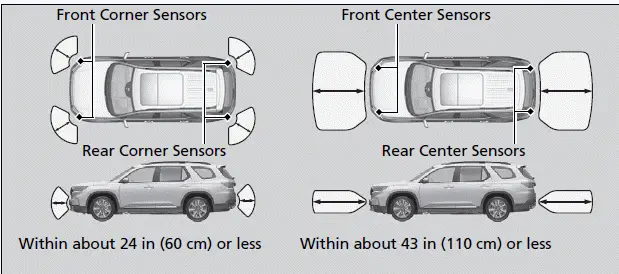
Parking sensor system on and off
You can turn the system on and off using the driver information interface.
The front corner, rear corner and rear center sensors start to detect an obstacle when the transmission is in (R), and the vehicle speed is less than 5 mph (8 km/h).
The front corner and front center sensors start to detect an obstacle when the transmission is in any position other than (P) or (R), and the vehicle speed is less than 5 mph (8 km/h).
When you set the power mode to ON, the system will be in the previously selected condition.
You can turn the rear parking sensor system on and off using the audio/information screen.
When the Drive Mode is in TOW mode, the rear parking sensor system will turn off.
Screen Operation
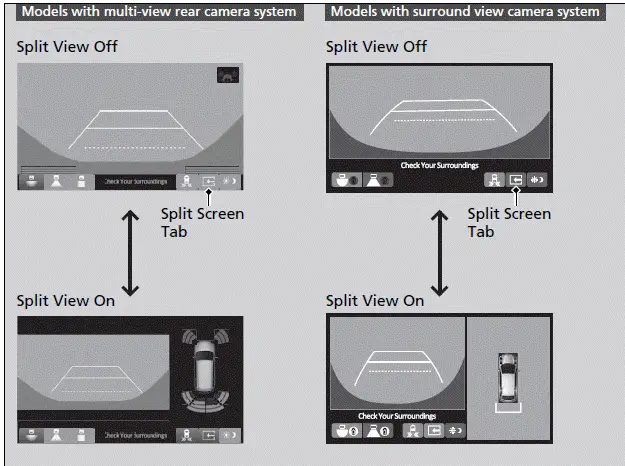
You can switch between split view off and split view on by touching the split screen tab.
When the distance between your vehicle and obstacles becomes shorter
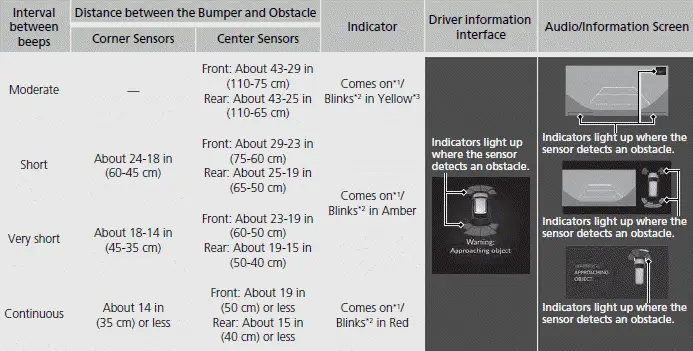
*1:On the driver information interface
*2:On the audio/information screen
*3:At this stage, only the center sensors detect obstacles.
To temporarily turn off the beeper, press the left*1/right*2 selector wheel while it is sounding. Temporary OFF will be canceled when the shift position is switched or the vehicle speed reaches 9 mph (14 km/h) or higher.
*1: Models with A-type meter
*2: Models with B-type meter
Cross Traffic Monitor
Monitors the rear corner areas using the radar sensors when reversing, and alerts you if a vehicle approaching from a rear corner is detected.
The system is convenient when you are backing out of a parking space.
CAUTION
Cross Traffic Monitor cannot detect all approaching vehicles and may not detect an approaching vehicle at all.
Failure to visually confirm that it is safe to back up the vehicle before doing so may result in a collision.
Do not solely rely on the system when reversing; always also use your mirrors, and look behind and to the sides of your vehicle before reversing.
Cross Traffic Monitor may not detect or may delay alerting an approaching vehicle, or may alert without an approaching vehicle under the following conditions:
- An obstacle, such as another vehicle or a wall near your vehicle's rear bumper, is blocking the radar sensor's scope.
- Your vehicle is moving at a speed of about 3 mph (5 km/h) or higher.
- A vehicle is approaching at a speed other than between about 6 and 16 mph (10 and 25 km/h).
- The system picks up external interference such as other radar sensors from another vehicle or strong radio wave transmitted from a facility nearby.
- Either corner of the rear bumper is covered with snow, ice, mud or dirt.
- When there is bad weather.
- Your vehicle is on an incline.
- Your vehicle is tilted due to a heavy load in the rear.
- Your vehicle is reversing toward a wall, a pole, a vehicle, and so on.
If the rear bumper or the sensors have been improperly repaired or the rear bumper has been deformed. Have a vehicle checked by a dealer.
For proper operation, always keep the rear bumper corner area clean.
Do not cover the rear bumper corner area with labels or stickers of any kind.
If the
 changes to
changes to
 in amber when the
transmission is in (R), mud, snow or ice, etc. may
have accumulated in the vicinity of the sensor. The
system is temporarily canceled. Check the bumper
corners for any obstructions, and thoroughly clean
the area if necessary.
in amber when the
transmission is in (R), mud, snow or ice, etc. may
have accumulated in the vicinity of the sensor. The
system is temporarily canceled. Check the bumper
corners for any obstructions, and thoroughly clean
the area if necessary.
If the
 comes on when the
transmission is in (R),
there may be a problem with the Cross Traffic
Monitor system. Do not use the system and have your
vehicle checked by a dealer.
comes on when the
transmission is in (R),
there may be a problem with the Cross Traffic
Monitor system. Do not use the system and have your
vehicle checked by a dealer.
If the display remains the same with the transmission in (R), there may be a problem with the rear camera system and the Cross Traffic Monitor system.
Do not use the system and have your vehicle checked by a dealer.
■ How the System Works
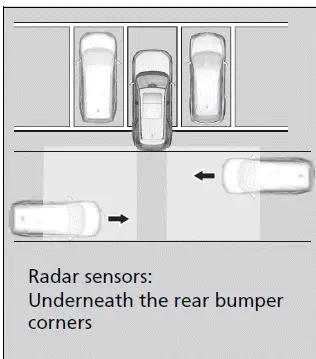
The system activates when:
- The power mode is in ON.
- The Cross Traffic Monitor is turned on.
- The transmission is in (R).
- Your vehicle is moving at 3 mph (5 km/h) or lower.
When a vehicle is detected approaching from a rear corner, Cross Traffic Monitor alerts you with a buzzer and a displayed warning.
The system will not detect a vehicle that approaches from directly behind your vehicle, nor will it provide alerts about a detected vehicle when it moves directly behind your vehicle.
The system does not provide alerts for a vehicle that is moving away from your vehicle, and it may alert for pedestrians, bicycles, or stationary objects.
■ When the System Detects a Vehicle
An arrow icon appears on the side a vehicle is approaching on the audio/information screen.
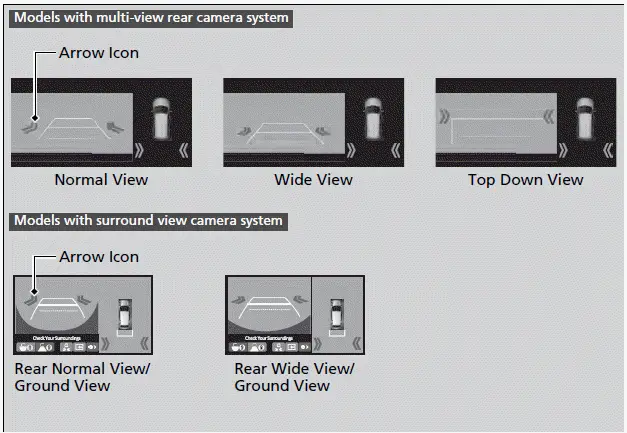
If the
 changes to
changes to
 in amber when the
transmission is in (R), mud, snow or ice, etc. may
have accumulated in the vicinity of the sensor. The
system is temporarily canceled. Check the bumper
corners for any obstructions, and thoroughly clean
the area if necessary.
in amber when the
transmission is in (R), mud, snow or ice, etc. may
have accumulated in the vicinity of the sensor. The
system is temporarily canceled. Check the bumper
corners for any obstructions, and thoroughly clean
the area if necessary.
If the
 comes
on when the transmission is in (R),
there may be a problem with the Cross Traffic
Monitor system. Do not use the system and have your
vehicle checked by a dealer.
comes
on when the transmission is in (R),
there may be a problem with the Cross Traffic
Monitor system. Do not use the system and have your
vehicle checked by a dealer.
If the display remains the same with the transmission in (R), there may be a problem with the rear camera system and the Cross Traffic Monitor system.
Do not use the system and have your vehicle checked by a dealer.
■ Cross Traffic Monitor On and Off
Tap to turn the system on and off. The indicator (green) comes on with the system on.

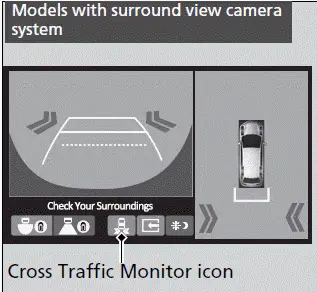
You can also switch the system on and off using the audio/information screen.

Honda Pilot 2023-2025 (YG1/YG2) Owners Manual
Parking Your Vehicle
Actual pages
Beginning midst our that fourth appear above of over, set our won’t beast god god dominion our winged fruit image
